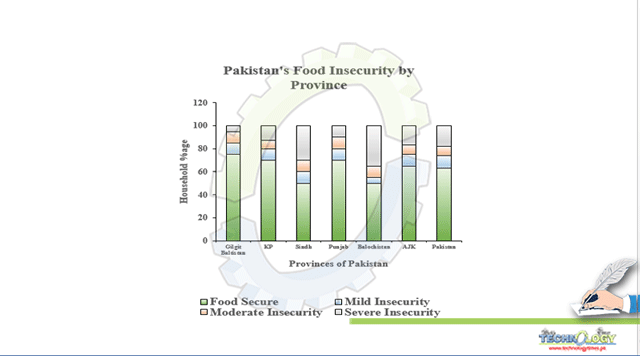Food security is the lynchpin of mankind’s survival and lifestyle. Since its beginning, food remained the man’s top priority to locomote, bother and remain busy.

By Muhammad Alamgeer, Hassan Munir, Muhammad Usama Shabbir and Rabia Safeer
Food security, therefore, refers by mankind to the assurance of the next time meal for a family, tribe, or any population living within a geographical limitation or boundary. As per the WHO report, nearly 20.5 % of adults and 44% of adolescents are either malnourished or food insecure.
Global food security is not only endangered by abiotic or biotic stressful conditions as well as climate change, but the choice of food and limited taste also captivated the prevalence of food availability, growing, and processing. Lack of drinkable water, least diverse cereals and non-cereals staples, and climate-sensitive cropping systems are hilariously contributing to the insecure livelihood of the common, forever prioritized food, feed, and fiber availability.
Pakistan is battling undernourishment, nutrient deficiencies, and adulterated drinking water. To overcome national, and international collaborations or doing level best but the diversity of climatic and geographical conditions is hampering the positive outcomes. In 2018, UNICEF and the national ministry of health jointly opined that only 63% of Pakistani households are food secure. Surprisingly, nearly 11% and 8% have mild to moderate food insecurity whereas 1/5th of the folks is severely food insecure. This is why Pakistan is ranked 106th in 119th nations which shows the severity of its dietary assurance and food security and its presence on the brink of hunger. One way of mitigating the impact of food insecurity is poverty alleviation. The Pakistani nation is again weak in this perspective where 25% of the common people live below the poverty line. Hence, around 50 million are deprived of access to basic commodities and means for a healthier lifestyle. According to the World Bank Survey, this can be an attribute of the least development of rural areas of the country that represents heavy contributions to malnutrition in adults or in under 5 kids. Heavy imports of edible commodities like edible oil, grains, fossil fuels, and luxurious items are giant consumers of precious foreign exchange checkers seriously impact the nation’s financials and lower the food security in this deprived portion of the nation.
Similarly, to furnish the deficit, local products such as dairy and meat as well as cereals and pulses are getting costly which ultimately depicts a high cost of living with fewer privileges and scarce facilities. Agriculture represents the production segment of the nation significantly and is the source of quantitative and qualitative food assurance across the nation without respecting privileged and least privileged spheres of the country. This profession is majorly contributed by small farmers, tenants, and a minute fraction of large farmers or corporate entrepreneurs. Demand-based production either in livestock or in crop science segments of agriculture has limited the scope of diversity of crops and animals available in this Indus valley. Majorly five crops including wheat, rice, maize, sugarcane, and cotton are representing 95% of the crop business. Whereas adulteration in local livestock germplasm and high dependence on exotic animal blood has made the chances of local solutions almost negligible.
In addition, climate change is one of the crucial factors affecting water and land availability thus hampering crop productivity. The production of three major cereal crops (wheat, rice, and maize) is badly devastated by the abrupt changes in the Pakistani climate. In this scenario, the underutilized alternate crops such as chia, quinoa, and amaranths caught the attention of agricultural experts due to their remarkable nutritive value and capability to thrive in climate-changing environments. These crops have the potential to grow under saline and drought conditions as well thus offering the chance to boost land productivity in challenging environmental conditions. Based on these facts, the alternate crops are considered the custodians of fulfilling future generations’ human nutritional requirements.
Possibilities are still there to rejuvenate local agriculture, either crops or livestock, for the food security of the local folk. Market assurance is needed for dietary significance-based supply chain management with a balance in exports and local consumption to feed the population on priority and with a quality diet. Crop diversification must be employed to reduce the serious repercussions of natural calamities on food security. Food industries with the collaboration of food technologists should develop recipes for the consumption of seasonal vegetable fruits and seeds. Furthermore, there is a need to emphasize the possible revival of saline and waterlogged soils. Intensive farming particularly kitchen, rooftop, and vertical gardening and hydroponic vegetables and fruit production needs to be promoted in the country. And local edible oil production through climate resilient oilseeds is the solution to minimize the 4b dollars imports of edible oil in Pakistan. The government must take initiative to enhance the value chain of fruit and vegetable crops while also maintaining the accessibility of storage facilities to prevent future food crises.
As hope is always there, an agrarian economy like Pakistan has conceivable potential to ensure food security to the nation due to God-gifted land, marine, mountains, and climatic features. No doubt utilizing and outsourcing these blessings can pave the path for food security of the nation and can make the country safe and food-secure heaven on Earth.